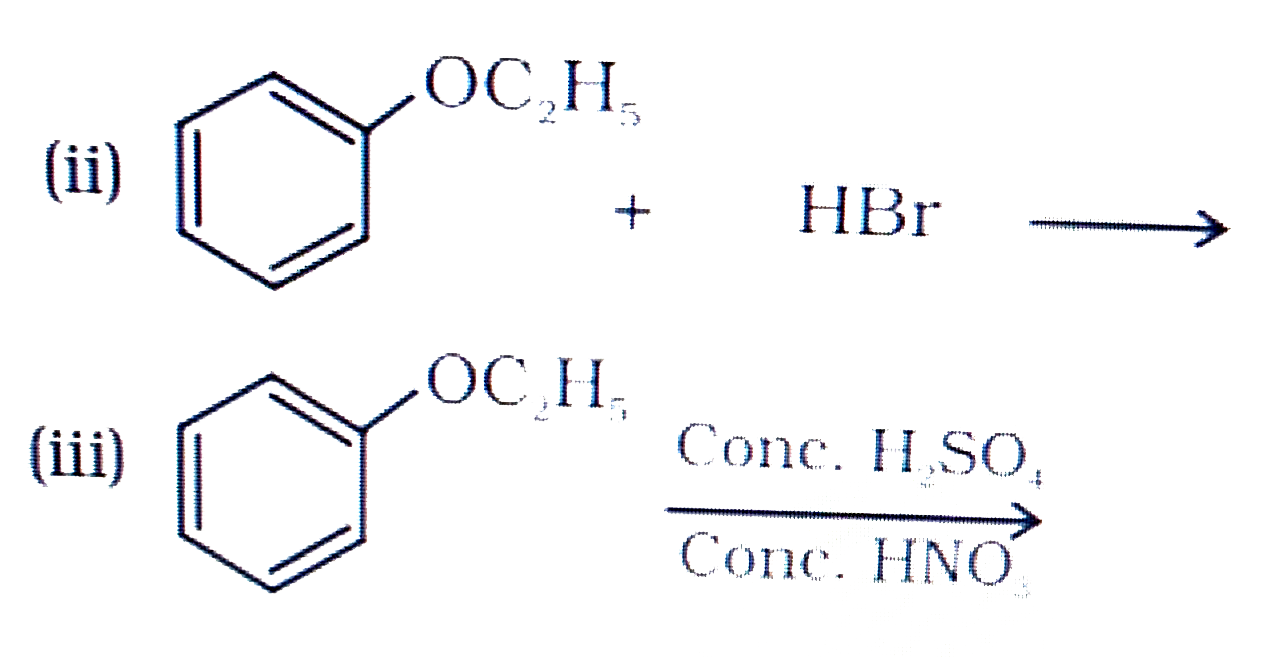Consider the following reactions:
I.C2H5−I+NH3→C2H5N⊕H3+Io−
II. C2H5−I+..PH3→C2H5P⊕H5 +Io−
III. C2H5−I+EtOo−→C2H5−OEt+Io−
IV. Me−⊕S−Me2+Oo−H→Me−OH+Me2S
In which of the above reactions does the rate of SN2 reactions increases with increase in solvent polarity?
(I)
(II)
(III)
(IV)
The correct Answer is:(a,b)
To determine in which of the given reactions the rate of SN2 reactions increases with an increase in solvent polarity, we need to analyze each reaction based on the nature of the nucleophiles and the presence of charged species.
1. Understanding SN2 Reactions:
- SN2 (Substitution Nucleophilic Bimolecular) reactions are characterized by a single transition state and involve a nucleophile attacking an electrophile, leading to the displacement of a leaving group.
- The rate of SN2 reactions is influenced by the polarity of the solvent, especially when charged species are involved.
2. Analyzing Each Reaction:
- Reaction I:
C2H5−I+NH3→C2H5No+H3+Io−
- Here, NH3 is a neutral nucleophile. Increasing solvent polarity will stabilize the transition state and potentially increase the reaction rate.
- Reaction II:
C2H5−I+PH3→C2H5Po+H5+Io−
- Similar to Reaction I, PH3 is also a neutral nucleophile. Thus, increasing solvent polarity may also increase the reaction rate.
- Reaction III:
C2H5−I+EtOo−→C2H5−OEt+Io−
- Here, EtO^- is a charged nucleophile. Increasing solvent polarity would stabilize the charged species and decrease the reaction rate.
- Reaction IV:
Me−(S)−Me2+Oo−H→Me−OH+Me2S
- In this reaction, O^- is also a charged nucleophile. Similar to Reaction III, increasing solvent polarity would decrease the reaction rate.
3. Conclusion:
- From the analysis, we find that the reactions where the nucleophile is neutral (Reactions I and II) would see an increase in the rate of SN2 reactions with increasing solvent polarity.
- Therefore, the reactions that fit the criteria are Reaction I and Reaction II.
Final Answer:
The rate of SN2 reactions increases with an increase in solvent polarity in Reactions I and II.
- SN2 (Substitution Nucleophilic Bimolecular) reactions are characterized by a single transition state and involve a nucleophile attacking an electrophile, leading to the displacement of a leaving group.
- The rate of SN2 reactions is influenced by the polarity of the solvent, especially when charged species are involved.
- Reaction I:
C2H5−I+NH3→C2H5No+H3+Io−
- Here, NH3 is a neutral nucleophile. Increasing solvent polarity will stabilize the transition state and potentially increase the reaction rate.
- Reaction II:
C2H5−I+PH3→C2H5Po+H5+Io−
- Similar to Reaction I, PH3 is also a neutral nucleophile. Thus, increasing solvent polarity may also increase the reaction rate.
- Reaction III:
C2H5−I+EtOo−→C2H5−OEt+Io−
- Here, EtO^- is a charged nucleophile. Increasing solvent polarity would stabilize the charged species and decrease the reaction rate.
- Reaction IV:
Me−(S)−Me2+Oo−H→Me−OH+Me2S
- In this reaction, O^- is also a charged nucleophile. Similar to Reaction III, increasing solvent polarity would decrease the reaction rate.
- From the analysis, we find that the reactions where the nucleophile is neutral (Reactions I and II) would see an increase in the rate of SN2 reactions with increasing solvent polarity.
- Therefore, the reactions that fit the criteria are Reaction I and Reaction II.
The rate of SN2 reactions increases with an increase in solvent polarity in Reactions I and II.
Topper's Solved these Questions
- AROMATIC COMPOUNDS AND ALKYL AND ARYL HALIDES BOOK - CENGAGE CHEMISTRY ENGLISHCHAPTER - AROMATIC COMPOUNDS AND ALKYL AND ARYL HALIDES EXERCISE - Exercises Multiple Correct Answers Type
15 Videos
- AROMATIC COMPOUNDS AND ALKYL AND ARYL HALIDES BOOK - CENGAGE CHEMISTRY ENGLISHCHAPTER - AROMATIC COMPOUNDS AND ALKYL AND ARYL HALIDES EXERCISE - Exercises Single Correct Answer Type
28 Videos
- AROMATIC COMPOUNDS AND ALKYL AND ARYL HALIDES BOOK - CENGAGE CHEMISTRY ENGLISHCHAPTER - AROMATIC COMPOUNDS AND ALKYL AND ARYL HALIDES EXERCISE - Exercises Linked Compreshension Type
11 Videos
- APPENDIX INORGANIC VOLUME 2BOOK - CENGAGE CHEMISTRY ENGLISHCHAPTER - APPENDIX INORGANIC VOLUME 2EXERCISE - Short Answer Type
179 Videos
- BIOMOLECULESBOOK - CENGAGE CHEMISTRY ENGLISHCHAPTER - BIOMOLECULESEXERCISE - Exercises Archives (Analytical And Descriptive)
8 Videos
Similar Questions
Complete the following reaction:
(i) Cl2+H2O→
(ii) XeF6+3H2O→
View SolutionComplete the following reactions:
(i) C2H4+O2→
(ii) 4Al+3O2→
View SolutionComplete the following reactions
(i) O2−2+H2O→ (ii) O−2+H2O→
View SolutionComplete the following reactions
(a)XeF4+H2O→
(b )XeF6+H2→
(c)XeF6+H2O→
(d)XeF6+NH3→
View SolutionName the following reaction.
C6H5−C≡NSnCl2+HCl−−−−−−−→C6H5−CH=N⊕H2]ClΘH2O−−→C6H5CHO+NH3
View SolutionThe products of the following chemical reactions are
(i)C2H5NH2+C6H5SO2Cl→
(ii) C2H5NH2+HNO2H2O−−→
View SolutionPredict the products of the following reactions:
(i) CH3−CH2−CH2−O−CH3+HBr→

(iv) (CH3)3C−OC2H5HI−−→
View SolutionThe reaction,
C6H5ONa+CO2+H2O→C6H5OH+NaHCO3
suggests that :
View SolutionComlete the following reactions :
i.C2H5NH2+CHCl3+Alc.KOH→
ii. C6H5N2Cl+H3H3PO2+H2O→
View SolutionIn the following reaction 'A' is :
C2H5MgBr+epoxyethaneH2O−−→A
View Solution
